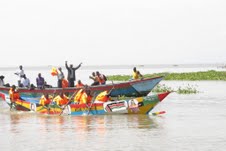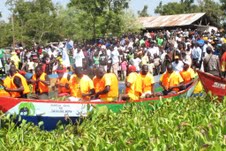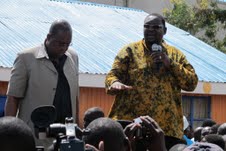BY DICKENS WASONGA.
WHEN talking about Kisumu County, it is Kisumu City that usually springs to mind.
But it is also difficult to divorce the region commonly referred to as Luo- Nyanza when discussing matters that are dear to Kisumu.
The two are interdependent, so to speak.
Although Kisumu County is home to Nyakach, Muhoroni, Nyando, Seme, Kisumu town East, Central as well as West constituencies, it’s the City that most people relate to more.
This may be so because of its commercial importance and value not only for the county but to the entire east African region where it’s believed to be an economic hub.
As a matter of fact, Kisumu is the headquarter to amongst other regional outfits, the Lake Victoria basin commission, one of the commissions established by the now revived east African community.
However, many leaders from this region have in the past faulted the media accusing it of painting the City and its people in bad light thus denying it the opportunity to attract investments.
It could be true or false but many leaders from this region believe the media has always been guided by mischief while reporting or telling the Nyanza stories.
To them, Nyanza, among other factors has remained behind due to bad publicity it gets in the mass media.
But if you ask me, what may qualify for one as news worthy piece may not necessarily be the same to what get covered in the media, whether in the print or electronic.
That is the way it is, but let me try to explain further.
Kisumu has in the past witnessed probably the worst forms of street protests that often degenerated into violent confrontations between the police and those demonstrating against one thing or another.
In most such encounters , some of the protesters ended up losing dear lives, killed by the officers or maimed by them .
Now, that is not the stuff one would ordinarily refer to as good news because it is not interesting reading about but remember the media has a role to play – key among them, to inform the masses.
As many police officers will tell you, none of those who have served in Nyanza are usually keen to take up such assignments as to contain rioters in this part of the world.
Call them petty, arrogant, naive or what you choose to, but the people of this region are not known to take excesses, whether from government or otherwise lying down and that probably explains the bitter protests and demonstrations which usually begin as peaceful demos in the region but sometimes turn to be very ugly in the end as witnessed in the past.
However, riots don’t mix well, either with development or peaceful coexistence and where there is violence; no development can ever take place.
But then again it is prudent to remember always that the media has a role; including telling you where there is chaos and therefore you cannot blame them for giving you negative publicity as long as you don’t conduct yourselves with decorum, right?
The media is only required to play that role responsibly and without omitting facts.
Interestingly however, what ails Kisumu, or what has held it back over the years, really does not only rest with riots and bad publicity, although these too have played an integral role.
The city, for instance proved pundits wrong in the recent past and manifested its ability to not only grow and attract more investors, but it also managed to bring back investor confidence which was at its lowest ebb in record time.
Examining the way in which Kisumu emerged strong, although badly wounded following the events after the disputed 2007 polls , one gets a clear indication that this city and the region has immense potential and energy for tremendous growth.
It is true the events of 2007-8 will forever remain edged in the minds of many and in the annals of history of this city for years to come but it also served as a big lesson on how not to manage conflicts arising either from social-economic or political disputes.
But if we want to remain true to ourselves, then let us accept facts as they are. The main problem for this region has been and remains bad leadership. A leadership without vision.
The leadership has overtime failed to show direction to the rest. Failing to guide its people and not leading from the front.
This leadership has been selfish, inept and above all not accountable to anyone but itself. This must not be tolerated moving forward.
Those who have been charged with the responsibility of managing public affairs have largely mismanaged it and the result of the rot that has existed over the years in most of our institutions is manifested all over.
Let’s face it; the issue has never been lack of capacity, in terms of potential to grow the region, far from it.
Land for example; as a factor of production is key and Nyanza is blessed with have huge chunks of fertile land most of which is just lying fallow.
Allow me then to ask the following:
Apart from not putting land into proper use, why have we failed to use the flood waters of river Nyando of Kisumu County and Kuja of Migori to be able to be food sufficient?
And why, for example, cant the rice farmers of Nyando be like their colleagues from Mwea in Embu? Can’t anyone please talk to them about value addition and facilitate them into adopting the same?
Can anyone please show me where serious mechanized large scale agriculture is taking place in our region save for those demonstration plots or in the sugar growing zones?
We must ask ourselves, what aren’t we doing right and how can we be helped to do it right?
Whenever it rains in this part of the world, it’s all misery, you all know it.
Rains to us bring doom as opposed to blessings. What does it take for us to learn a thing or two about building proper dykes like our brothers and sisters of Budalang’i to control flooding?
Come to think of it, what have we done with the huge and the untapped natural resource that is Lake Victoria?
Now the vast lake is chocking under the dreaded hyacinth weed and the local leadership, whether elected or otherwise is not mentioning it anywhere.
Like the rest of the country, Nyanza has had its fair share of challenges and predicaments but as a region; this is the time to seize the moment as provided for in law through devolution to fix a few things and get most of them right.
In the same vain we must examine where we have come from even as we move forward.
Now, power has been devolved to us. We can choose to utilize our resources sustainably to create more wealth and grow or remain in abject poverty for ever.
In Kisumu, scores of industries remain inactive while others are completely shut down.
The Sugar sub sector which was once vibrant, offering hope to many farmers and their families is today registering lackluster performance.
Most of the public milling firms are at the brink of closure, sagging under huge debts which are uneconomical to service.
Cotton farmers who heeded calls by the government to revive cultivation of the cash crop are today stuck with tones of their produce in their farms due to lack of market or low prices offered to them by middle men.
Sadly nothing positive seem to come from this region which was once known as the home of great scholars.
Hundreds of thousands of youths are unemployed with most of them taking to riding bicycles with university degrees to boot in order to earn a living.
Many more are idling along and about the streets of major towns in the region and the temptation to venture into crime are real.
The only outstanding development in the region which one can single out is the Kisumu International Airport whose commissioning rekindled hope amongst the locals.
But with little or nothing to export, even the facility may largely remain underutilized or better still serve only those who can afford air fare.
Kisumu had its past glory.
Having emerged sometime in 1901 during the building of the Kenya –Uganda railways ,it provided the much needed link amongst the British east African protectorates of the time and indeed to the rest of the continent.
Known only as Port Florence then, Kisumu was clean, green, young and promising even at its nascent formations.
The lake next to which it sits had clear waters.
The population then was very small and the existing houses at the time were built in good order.
Land, mainly in the hands of government was huge, with the railways cooperation having most of it. Planning for what would become the third largest City in Kenya was proper and space for future expansion was factored in.
Like in other towns, roads were well maintained; water transport was vibrant with most shipping companies preferring to dock at the Kisumu pier.
Satellite towns like Kibos, Muhoroni and Butere in western region among others, flourished because the railway transport worked.
It was also the time Kendu bay, Homa bay, Asembo bay and the like were famous since the lake transport was effective and reliable.
But things began taking a downward trend with astonishing results. Where streets were fully lit, today Kisumu is a pale shadow of its former self.
While most towns are active at night trying to register a twenty four hour economy, Kisumu goes to sleep early.
In fact, save for the vibrant bars that remain active past mid night in most of the city estates and others within town, nothing can be noticed at the CBD after 9pm.
Apart from the Nakumatt supermarket that operates 24 hours within the CBD, the rest of the business premises remain a no go zone immediately after 7.30pm when most of them close.
The streets are dark with the posh Milimani estate being the worst lit and most dangerous if the increased house brake ins and attacks mainly targeting senior government employees in this hood is anything g to go by .
With no proper street lighting and enhanced security, no business activities can be undertaken, probably explaining why most parts of the city goes to sleep early.
As the new devolved systems take effect, most people are keenly watching how the governor and his team will strive to correct the wrongs that Kisumu has witnessed in the past.
This is why the local residents cannot allow their newly elected leaders to paralyze operations at the county assembly like their colleagues elsewhere in demands for better pay when a lot still needs to be fixed.
Most investors would for example wish to see the issue of land addressed.
This is probably amongst the growing list of towns where trying to buy land can be such a risky engagement.
Even people who are legally allocated land and are paying land rates are not immune to the risk of losing such property to swindlers who are all over the place.
Cases of land fraud are in their thousands as victims make endless trips within the court corridors in pursuit of justice in Kisumu.
Double allocation of land is no longer strange even as number of fraudsters and land sale cartels keeps growing each passing day.
Corruption has fueled the problem and the demand for housing in a town where it takes months to get development plans approved has not helped matters.
Even the ambitious slums upgrading program that began on a high note spearheaded by the ministry of housing has little impact to write home about.
The city fathers must quickly adopt new ways and methods especially on how they view and handle investors and do so fast enough to conform to devolution.
The perception that investors are only foreigners or people from outside the country must stop.
Developers who buy land in the town with intention to invest in real estate for example go through rough times indeed.
For starters , the development plans here attract very high fees and takes ages to approve although the same council by-laws requires that plots be developed within one year after allocation.
Stringent requirements sometimes leave many would -be developers dejected even in the face of the biting housing shortage in the town.
Even those who manage to get the approvals soon find that some of the essential services that would ordinarily be available courtesy of various government agencies to make investment affordable are lacking.
Most estates within Kisumu for example, are not connected to the main sewer system which is amongst the key mandates of Kisumu water and Sewerage Company.
KIWASCO has failed over the years to ensure the number of residents or homes connected into the sewer system is expanded.
What this means is that any developer who put up a housing unit in areas not covered must construct septic tanks which in most cases pushes tremendously the general cost of their projects.
While we impress upon investors to consider coming to Kisumu, the authorities must ensure the infrastructure available is supportive of such economic endeavors.
The roads in the urban area of Kisumu are pathetic and must be fixed. Despite huge amounts of money it receives yearly for upgrades there is little really on the ground to show for it.
Most roads in the industrial area for example are not tarmac ked and others that were are now completely worn out.
The streets are clean but the estates are doomed. Residents are forced to enter into collection arrangements in the estates with private garbage collectors to do what we expect the council to do for us since we pay taxes to them.
In fact Kisumu officially declared it had failed to get a dumping site even after allocating sh 10 M in the past for a dump site.
The Kisumu governor Mr Jack Ranguma who is expected to soon form a commission to run the city affairs on behalf of the residents must henceforth also find it his priority to stop those who pollute the lake with impunity.
Once billed as the second largest fresh water lake in the world, many are now debating whether this is still true of Lake Victoria given the increasing degradation of its waters.
Some of the industries, sugar millers and even local authorities neighboring the lake are known to be amongst the chief polluters and they seem to be getting away with it over the years.
These and many more are what many people from this region would want to see fixed and fixed completely by the devolved government and if they fail we will no longer have the luxury of blaming the national government or national leadership as has been the norm whenever we get it wrong.
END.



 Kisumu Town West MP Olago Aluoch, left and former area MP Rev Ken Nyagudi address the protesters outside ODM party office in Kisumu yesterday.
Kisumu Town West MP Olago Aluoch, left and former area MP Rev Ken Nyagudi address the protesters outside ODM party office in Kisumu yesterday.